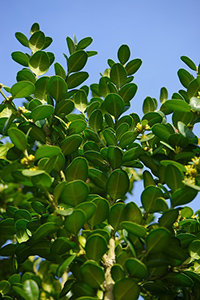The boxwood plant was once used to combat malaria as a substitute for quinine, a substance native to South America and not always available in Europe. However, its use as a medicinal herb has decreased because of its toxicity.

Boxwood Plant Scientific Facts
- Scientific name: Buxus sempervirens L.
- Other names: Box Tree.
- French: Buis.
- Spanish: Boj.
- Environment: Common in mountainous areas of Central and Western Europe, it also grows along the Atlantic coast of North America and, with less frequency, in mountainous regions of South America.
- Description: Shrub of the Buxaceae family, growing from one to two meters high, with small, evergreen, oval, and bright leaves and small, yellowish flowers.
- Parts of the plant used medicinally: The leaves and the root bark.

Healing Properties and Warning
The entire plant, mainly its leaves and the root bark, contains four steroid alkaloids, of which buxen is the most active. Moreover, boxwood contains essential oil, resin, tannin, and vitamin C.
The plant has sudorific, febrifuge, and mild cholagogue properties. Boxwood has been used for fever diseases (influenza and malaria) and gall bladder disorders. Its intense febrifuge action can be helpful when other remedies fail. A decoction of boxwood leaves, applied as a lotion on the scalp, can sometimes make hair grow again.

WARNING! Never exceed the recommended dose. When taken in high doses, it can cause vomiting and nervous disorders. We recommend that you avoid using it when there is low blood pressure, weakness, pregnancy, or breastfeeding. Never give it to children.
How to use Boxwood
- Decoction with 30-40 g of leaves and/or root bark per liter of water. Drink up to three cups daily, sweetened with brown sugar, molasses, or honey.
- Lotions. With a concentrated decoction of leaves (80-100 g per liter of water).
Frequently Asked Question
What are the traditional medicinal uses of the boxwood plant?
Boxwood has a long history of use in various traditional medicine systems. Some historical applications include:
Treating fevers
Acting as a tonic
Supporting immune function
Managing rheumatism and syphilis
Is there scientific evidence to support the health benefits of the boxwood plant?
Research into the potential benefits of boxwood is minimal. Some very early studies have suggested that a specific boxwood extract (SPV 30) may delay the progression of HIV/AIDS. However, more research is needed to confirm this and determine the safety and dosage.
Are there other purported benefits of using boxwood plants?
Some claim boxwood can help with conditions like malaria and arthritis or “detoxify the blood.”
Can I consume parts of the boxwood plant directly?
The leaves and other parts of the boxwood plant contain toxic alkaloids. Consuming them can have serious side effects, including death. Traditional preparations may have specific processes to reduce toxicity, but these are unsafe to attempt at home.
How is boxwood extract different from the raw plant?
Boxwood extracts are processed to isolate specific chemical compounds. While they should still be used cautiously, they are considered less dangerous than ingesting the plant directly.
Are there any known side effects of using boxwood?
Reported side effects of boxwood, even in processed extracts, include:
Nausea and vomiting
Dizziness
Convulsions
Respiratory difficulty
Potential liver and kidney damage
Who should NOT use boxwood?
The safety of boxwood has not been adequately studied. To be safe, the following should avoid boxwood in any form:
Pregnant or breastfeeding women
Children
Anyone with existing health conditions
Anyone taking prescription medications
Are there safe ways to use the fragrance of boxwood?
Boxwood has a characteristic scent. Enjoying its natural fragrance from a safe distance is unlikely to be harmful. Be cautious with aromatherapy, which involves diffusing the plant’s essential oils, as this could be problematic.
What forms of boxwood are used in research?
Highly concentrated extracts of specific alkaloids within the plant are primarily used in limited research settings.
Where can I find reliable information on the health effects of boxwood?
Due to the toxicity and lack of proven benefits, most reputable health organizations do not promote boxwood use. Sources of information to consider:
Your doctor or pharmacist
The National Institutes of Health (NIH): https://www.nccih.nih.gov/
Reputable medical research publications
DISCLAIMER: All content on this website is presented solely for educational and informational objectives. Do not rely on the information provided as a replacement for advice, diagnosis, or treatment from a qualified medical expert. If you are pregnant, nursing, or have any preexisting medical concerns, talk to your doctor before using any herbal or natural medicines.
REFERENCES
- George D. Pamplona-Roger, M.D. “Encyclopedia of Medicinal Plants.” George D. Pamplona-Roger, M.D. Encyclopedia of Medicinal Plants. Ed. Francesc X. Gelabert. vols. 2 San Fernando de Henares: Editorial Safeliz, 2000. 748. Print. [boxwood plant]
- PubMed (peer-reviewed medical articles): https://pubmed.ncbi.nlm.nih.gov/
